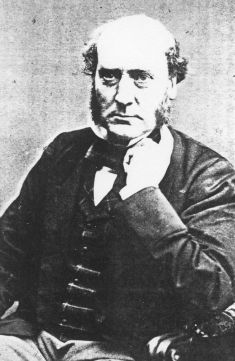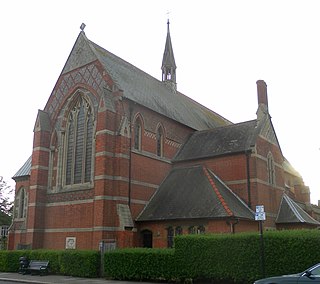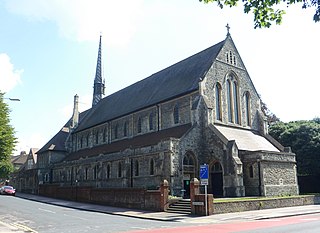
Sir George Gilbert Scott, largely known as Sir Gilbert Scott, was a prolific English Gothic Revival architect, chiefly associated with the design, building and renovation of churches and cathedrals, although he started his career as a leading designer of workhouses. Over 800 buildings were designed or altered by him.

Willenhall is a market town in the Walsall district, in the county of the West Midlands, England, with a population taken at the 2021 Census of 49,587. It is situated between Wolverhampton and Walsall, historically in the county of Staffordshire. It lies upon the River Tame, and is contiguous with both Wolverhampton and parts of South Staffordshire. The M6 motorway at Junction 10 separates it from Walsall.

Llandovery is a market town and community in Carmarthenshire, Wales. It lies on the River Tywi and at the junction of the A40 and A483 roads, about 25 miles (40 km) north-east of Carmarthen, 27 miles (43 km) north of Swansea and 21 miles (34 km) west of Brecon.

Wednesfield is a town and historic village in the City of Wolverhampton, in the county of the West Midlands, England, It is 2 miles (3.2 km) east-northeast of Wolverhampton city centre and about 10 miles (16 km) from Birmingham and is part of the West Midlands conurbation. It was historically within the county of Staffordshire.

Great Wyrley is a village and civil parish in the South Staffordshire district of Staffordshire, England. It forms a built-up area with nearby Cheslyn Hay, Churchbridge, Landywood and Little Wyrley. It lies 6 miles (9.7 km) north of Walsall and a similar distance from Wolverhampton. Cannock is directly north of the village. It had a population of 11,060 at the 2011 census.

Great Haywood is a village in the civil parish of Colwich, in the Borough of Stafford in the county of Staffordshire, England, just off the A51 and about 5 miles (8.0 km) northwest of Rugeley and 7 miles (11 km) southeast of the town of Stafford.

Essington is a village and civil parish in the South Staffordshire, district, in Staffordshire, England, near the city of Wolverhampton and towns of Walsall, Bloxwich, Cannock and Brewood. The villages of Cheslyn Hay, Great Wyrley, Coven, Penkridge and Featherstone are also nearby. The village forms part of the Staffordshire/West Midlands border. The parish includes the hamlet of Springhill. In 2021 the parish had a population of 5,200.

A tin tabernacle, also known as an iron church, is a type of prefabricated ecclesiastical building made from corrugated galvanised iron. They were developed in the mid-19th century, initially in the United Kingdom. Corrugated iron was first used for roofing in London in 1829 by civil engineer Henry Robinson Palmer, and the patent was later sold to Richard Walker who advertised "portable buildings for export" in 1832. The technology for producing the corrugated sheets improved and, to prevent corrosion, the sheets were galvanised with a coating of zinc, a process developed by Stanislas Sorel in Paris in the 1830s. After 1850, many types of prefabricated buildings were produced, including churches, chapels and mission halls.

Pelsall is a village in the Metropolitan Borough of Walsall, West Midlands, England. Forming part of the borough's border with Staffordshire, Pelsall is located 4 miles north of Walsall, midway between the towns of Bloxwich and Brownhills and 4 miles northwest of Aldridge. The southern edge of Cannock Chase is 6 miles to the north. Pelsall is also 8 miles southwest of Lichfield and 8 miles northeast of Wolverhampton.

St Philip's Church is a Church of England parish church in Hove, in the city of Brighton and Hove, England. It was opened in 1895 and consecrated in 1898 on New Church Road, near Aldrington's parish church of St Leonard's. It is a Grade II listed building. It was closed in October 2023.

St John the Evangelist's Church is an Anglican church in the Preston Village area of Brighton, in the English city of Brighton and Hove. The Grade II listed building, designed by Sir Arthur Blomfield, was started in 1901 but did not take its present form for another quarter of a century. In the meantime, the nearby parish church of Preston was severely damaged by fire, and the new church was granted the parish church status which it still retains.

St Peter's Church is a Roman Catholic church in the Aldrington area of Hove, part of the English city of Brighton and Hove. It is one of three Roman Catholic churches in Hove and one of eleven in the wider city area. Built between 1912 and 1915 in a red-brick Romanesque style, its tall campanile forms a local landmark. It has been listed at Grade II by English Heritage in view of its architectural importance.

St John the Evangelist's Church is the Church of England parish church of Burgess Hill, West Sussex, England. It is a Gothic Revival church built of local bricks. It was consecrated in 1863 and was the town's first Church of England church. Since then it has administered several other churches in the town as either mission chapels or daughter churches, but all have either closed or been given their own parishes. The church is a Grade II* Listed Building.

The Queen's Hall is a performance venue in the Southside, Edinburgh, Scotland. The building opened in 1824 as Hope Park Chapel and reopened as the Queen's Hall in 1979.

St John the Evangelist's Church is the Anglican parish church of the Upper St Leonards area of St Leonards-on-Sea, a town and seaside resort which is part of the Borough of Hastings in East Sussex, England. The present building—a "very impressive and beautifully detailed" church in the Gothic Revival style, with a landmark tower—combines parts of Arthur Blomfield's 1881 church, wrecked during World War II, and Harry Stuart Goodhart-Rendel's 1950s rebuild. Two earlier churches on the site, the second possibly designed by Samuel Sanders Teulon, were themselves destroyed earlier in the 19th century. The rich internal fittings include a complete scheme of stained glass by Goodhart-Rendel's favoured designer Joseph Ledger and a 16th-century painting by Ortolano Ferrarese. English Heritage has listed the church at Grade II* for its architectural and historical importance.

Christ Church is an Anglican church in the town and seaside resort of St Leonards-on-Sea, part of the Borough of Hastings in East Sussex, England. Opened as the town's third Anglican church in 1860 to serve a rapidly developing residential area and to accommodate poor worshippers who could not afford pew rents at the fashionable St Leonard's and St Mary Magdalene's Churches, the original building was superseded by a much larger church built next to it between 1873 and 1875. Prolific ecclesiastical architect Sir Arthur Blomfield's simple Gothic Revival design forms a landmark on one of St Leonards-on-Sea's main roads, continues to serve a large area of the town and maintains a strong Anglo-Catholic tradition. It has been described as Blomfield's "finest achievement in Sussex" and "one of the main centres of Anglo-Catholic worship in Southern England". The interior fittings are the best of any church in the borough, and the design has been called one of Blomfield's most successful. St John the Evangelist's Church, founded as a daughter church nearby in 1865, also continues to thrive as a separate parish church. Historic England has listed Christ Church at Grade II* for its architectural and historical importance.

All Souls Church is a former Anglican church that served the Clive Vale suburb of Hastings, a seaside resort town and borough in the English county of East Sussex, between 1890 and 2007. The "large [and] serious town church" has been described as one of the best works by prolific ecclesiastical architect Arthur Blomfield. Built almost wholly of brick, inside and out, it dominates the streetscape of the late Victorian suburb and has a tall, "dramatic" interior displaying many of Blomfield's favourite architectural features. The church also has Heaton, Butler and Bayne stained glass and an elaborate reredos. Falling attendances and high maintenance costs caused it to close after a final service in November 2007, and the Diocese of Chichester officially declared it redundant soon afterwards. English Heritage has listed it at Grade II* for its architectural and historical importance.

Fulford is a village and civil parish about 5 miles (8 km) north east of Stone, in the Stafford district, in the county of Staffordshire, England. The parish includes the settlements of Crossgate, Leadendale, Meir Heath, Mossgate, Rough Close, Saverley Green, Stallington, Townend and part of Blythe Bridge. In 2011 the built-up area had a population of 650 and the parish had 5,931. The village is on one of the tributaries of the River Blythe. Fulford became a conservation area in 1978. The parish is one of the largest in the Stafford district. The parish touches Forsbrook, Hilderstone, Stone Rural, Barlaston and Draycott in the Moors. Fulford is the highest point in the Stafford district and varies between 650 feet (198 m) and 730 feet (223 m) above sea level.




















